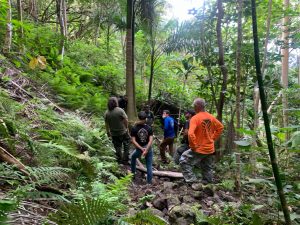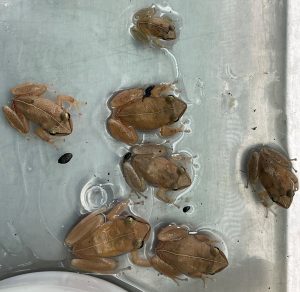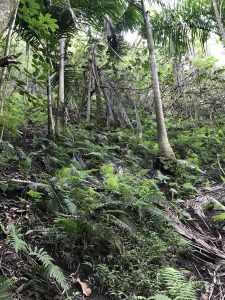Coqui Frog Infestation Found in Remote Area of Waimanalo
Posted on Apr 16, 2021 in MainHAWAI`I DEPARTMENT OF AGRICULTURE
DEPARTMENT OF LAND AND NATURAL RESOURCES
JOINT NEWS RELEASE
April 16, 2021
HONOLULU – The Hawai`i Department of Agriculture (HDOA) has detected a coqui frog infestation in a remote area of Waimanalo and is coordinating a multi-agency eradication effort including the Department of Land and Natural Resources (DLNR), Hawai`i Invasive Species Council (HISC), Oahu Invasive Species Committee (OISC) and the Department of Hawaiian Home Lands (DHHL). The primary area impacted appears to be about an acre along the base of the mountains in Waimanalo where 65 coqui frogs have been hand captured so far. An incident command structure has been established to coordinate and manage this eradication effort.
“Unfortunately, this coqui infestation is in a remote area and has gone undetected for some time despite HDOA staff responding to reports and conducting night monitoring for more than 10 years in Waimanalo,” said Phyllis Shimabukuro-Geiser, chairperson of the Hawai`i Board of Agriculture. “We appreciate the assistance of our partner agencies in this effort to contain and eradicate this coqui population and we continue to urge residents to report any suspected coqui infestations.”
DLNR Chair Suzanne Case said, “the Department of Agriculture recently contacted the Department of Land and Natural Resources about the Waimanalo coqui frog infestation. Coqui is a top priority species for the O`ahu Invasive Species Committee, along with Miconia and little fire ant, and we will be working closely with HDOA to do everything we can to contain this critical threat.”
In early February 2021, a resident reported hearing coqui frogs in the area, but no frogs were heard or captured that night by HDOA Plant Quarantine Branch (PQB) inspectors. Inspectors returned to the area five times since that report and were able to capture one to three coqui frogs each time and were then able to hear some coquis in the distance. PQB inspectors worked to get approval to search surrounding properties that were under the jurisdiction of the Honolulu Board of Water Supply, DLNR, and DHHL.
On March 30th, a team of six PQB inspectors searched the area, were able to pinpoint the area of infestation, and were able to capture 33 coqui frogs. Another team of PQB inspectors subsequently conducted a survey on Friday evening, April 9th, to further determine the extent of the infestation. An additional 18 coqui frogs were captured that night.
On April 14th, a crew from PQB, DLNR, and OISC conducted a daytime survey to map out the terrain which helped to determine the best strategy to contain and eradicate the infestation. The survey allowed the team to comprehensively assess the area and surrounding vegetaion, providing them a baseline to begin the process of coordinating resources to conduct habitat modification. The survey also indicated that traditional means of getting treatment equipment into the area would not be feasible, primarily due to the terrain and alternative options are being discussed.
On April 15th, a team of five PQB inspectors captured an additional 14 frogs, conducted some limited habitat modification efforts and conducted additional surveys in areas immediately adjacent to the infestation. The team did not discover any additional populations.
The immediate concern is to prevent the frogs from spreading to other areas. PQB staff will be routinely conducting night searches to remove frogs from the immediate area and ensure that the frogs are not spreading to adjacent areas. DLNR and OISC will be utilizing their expertise in conducting habitat modification of the infested area by making the surrounding areas unfavorable for the frogs and adding an additional buffer zone around the infestation to further reduce the likelihood of spread. Once it can be safely conducted, treatment of the infested area will occur, followed up with night-time monitoring efforts to ensure the frogs are eradicated from the area.
The coqui frog, Eleutherodactylus coqui, was first detected in the late 1980s on Hawai`i Island where they have become established. The frogs are a major noise nuisance and also pose a threat to native eco-systems. Their diet includes insects and spiders and they compete with native birds and other endemic fauna. Since its detection in Hawai`i, significant efforts have been ongoing to prevent the spread of coqui to uninfested islands. Detection of coqui in remote areas is difficult as they are heard mainly at night.
The PQB responds to all credible reports of coqui on O`ahu, Kaua`i, and Maui. In addition, the PQB works with landowners to eradicate coqui on uninfested islands and also works with shippers who are transporting from infested areas to ensure shipments are free of coqui. This is done through best management practices, such as witnessing treatments and inspections.
In June 2003, a coqui infestation was detected in a 9-acre forested area in Wahiawa including part of the U.S. Army’s East Range. A coordinated effort involving HDOA, DLNR, OISC and the U.S. Army was successful in eradicating that population using citric acid treatments. The last coqui was heard in November 2006 and surveys continued until August 2007, when HDOA declared that the population was eradicated. The total cost of the three-year effort was about $235,000.
Anyone hearing coqui frogs on O`ahu, Kaua`i and in Maui County should contact the State’s toll-free Pest Hotline at 643-PEST (7378). To hear what a coqui frog sounds like, go to: https://www.hear.org/AlienSpeciesInHawaii/species/frogs/
###




